by Nina

There’s something surprising you probably don’t know about me: I’ve been using computers to write, edit, and publish documents as well as to email since 1976! The photo above shows me and another writer/editor at Stanford Research Institute in Palo Alto, California in around 1978, with both of us using the very first mouse and window-based interface, invented by our boss, Doug Engelbart, and his group at the Augmentation Research Center. (This was before the personal computer so those things in front of us are “terminals” connected to a mainframe computer, but see if you can spot the mice.) After that first job, I became a full-fledged technical writer and worked for 20 years in the software industry, writing manuals about software and using computers to do all my work. And after that, I used a personal computer to write fiction, yoga books, this blog, and so on. The reason I’m telling you this is because I have a lot of experience sitting hunched in front of a computer and know all too well how it affects your posture.
Although I had my first experiences with yoga in the early 80s (loved it!), it wasn’t until the late nineties that I got serious about practicing every day. And it wasn’t until after that when I started studying with Rodney Yee that I had someone make specific recommendations to me about how I could improve my posture. What Rod suggested I practice every day to counteract my slouch and head forward posture was a supported backbend over a block. I took his advice and practiced it every single day for three minutes and it really opened up the front of my chest and neck.
Interestingly, this is basically the same single posture that Timothy McCall recommended in this post his post Cultivating Healthy Posture with a Simple Restorative Pose. In that post, he recommended practicing a supported backbend pose to counteract poor posture (head forward syndrome qualifies as one form of that). He says that when we have a long-term habit of slouching, it may not just be as simple as to start sitting or standing up straight. Long-term slouching leads to shortening of muscles in the front of the upper body, as well as of the fascia, the connective tissue that surrounds and interpenetrates the muscles, and which can limit movement. And this is going to be true for head forward syndrome as well.
And because longer holds of poses are necessary to help lengthen the fascia, he believes staying in a pose for a few minutes may be ideal. Since that’s hard to do in most regular asanas, particularly the backbends, which open up your front body, he recommended a simple supported backbend, though he suggests a blanket roll under the shoulder blades.
Because these days we are all using computers more than ever as well as smart phones, I thought it would be a good idea to revisit this topic. Besides stretching your front body with a passive backbend, I also have some suggestions for how to strengthen your upper back and neck muscles, and to work mindfully on the alignment of your head and neck over your torso.
Stretching Your Front Body and Neck
As both Rodney Yee and Timothy McCall recommended, the single best pose to practice to improve your posture is a simple supported backbend, which you should practice several times a week, for 3 minutes or more at a time. There are many different versions of the supported backbend, and you can choose any version that seems best to you. Make sure the one you choose is comfortable, so you can stay for three or more minutes without pain or discomfort.
Here are three versions that I happen to have photographs of. The third version shown here actually has the head higher than the torso and at first this version seems like it won’t stretch your neck. However, my father had head forward syndrome so severe that he couldn’t even lie with his head flat on the floor—he couldn’t even sleep on his back with a pillow—so even a backbend with a high support for his head was a stretch for him. So for some of you (or your students) it may be necessary to start with your head supported in these backbends and gradually lower the support until you reach a point where you can be comfortable with your head even with and eventually lower than your torso.
The first one provides the most stretch. If you can comfortably bend your neck back, this version would be a good one. The head is supported on a very low blanket simply to make the pose more comfortable. If the bolster is too much for you—or you just don’t have one—you can used a rolled up blanket instead.
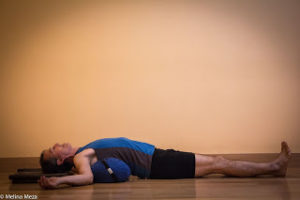
If you can’t bend your neck back below your torso or its too uncomfortable but you can lay it flat, you could do this version, where you head is supported on a blanket stack even with your torso. You can also use a thin blanket roll instead of the block on its lowest height. You could also use a stack of blankets like this with a bolster.
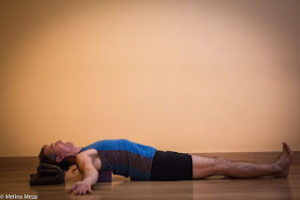
If you can’t even lay your head flat or it is too uncomfortable, you may need to prop your head up higher than your torso. You can do this with a block as shown here or you could do it with a large stack of blankets.
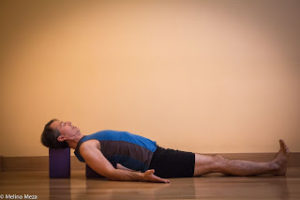
See Cultivating Healthy Posture with a Simple Restorative Pose for Timothy’s instructions on how to practice the pose (his suggested propping is a bit different). For more about practicing simple supported backbends, see Featured Pose: Supported Backbend.
Strengthening Your Back Body and Neck
I think that in addition to stretching the front of your body and neck, strengthening your upper back and neck muscles would be beneficial because those can become weak from slouching. Regularly practicing Locust pose (Salabasana) would easily do the trick. Just be sure that when you lift your head in this pose not to cause strain by bending your neck back too far (this is especially true if you have head forward syndrome). Sandy’s neck looks pretty good to me in this pose, although if your neck is very stiff you should be careful with how far you take it back. See Strengthening Pose of the Week: Locust Pose for instructions for practicing Locust as well as several different variations. 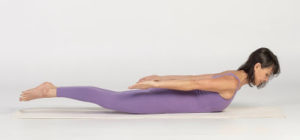
Mindfulness About Alignment
Practicing Mountain pose (Tadasana) is a good way to cultivate awareness of your habitual posture and to move into a healthier alignment, where your head and neck are in line with your spine. Because your habit is going to feel more comfortable than a new alignment, have a partner or a teacher help adjust your head and neck in the pose.
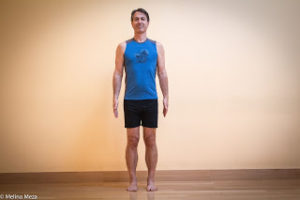
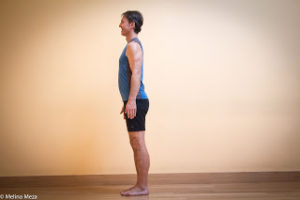
So practice this pose in the yoga room and then, when you’re out in the real world, take the new awareness you have to change your habitual posture while you’re working, standing around, or, yes, even texting. (Just because almost everyone texts by bending their necks to look down at the phone doesn’t mean you have to do it that way, too. See if you can find a way to prop it up on something higher.)
I hope these suggestions are helpful! And I would love to hear what you think after you’ve experimented with these ideas or if you have some other ideas.
Follow Yoga for Healthy Aging on Facebook ° To order Yoga for Healthy Aging: A Guide to Lifelong Well-Being, go to Amazon, Shambhala, Indie Bound or your local bookstore.


Leave A Comment